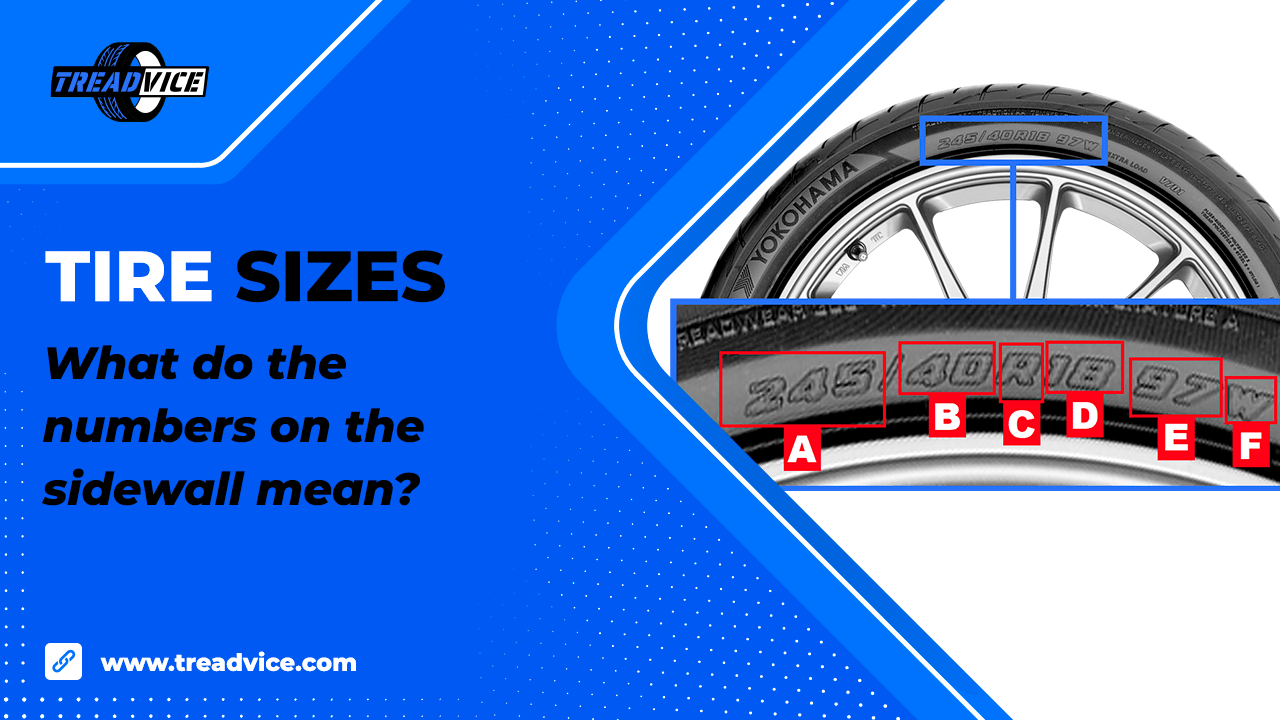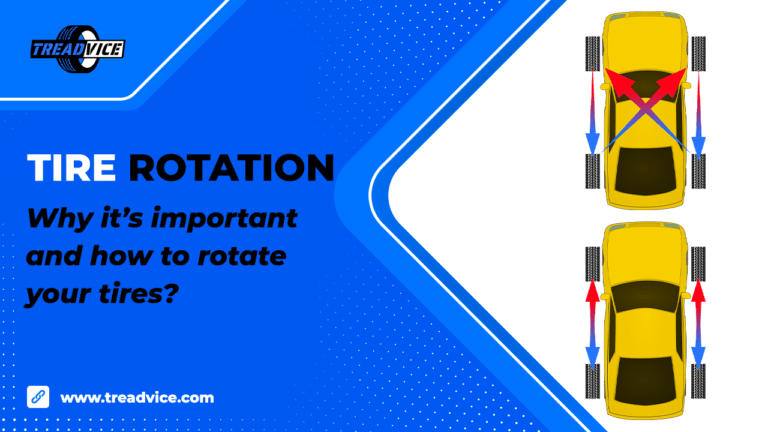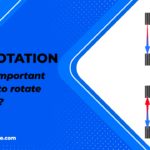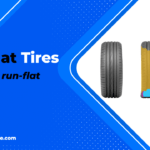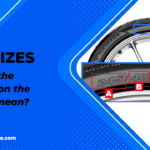Have you ever glanced at the side of your car’s tires and wondered what those seemingly random numbers and letters mean? You are not alone, so don’t worry.. Tire sizes and numbers can be confusing to decipher, but fear not! In this guide, we’ll debunk the mystery around tire size codes and show you how to decipher them like an expert.
But why bother understanding tire sizes, many people might ask? Well, imagine the scenario below:
“You’re at the local tire shop as you want to buy some new tires ( because of the donuts you did in the parking lot last night… ), and the salesman asks you about your tire size. The only thing you can do is staring back blankly like a confused potato in a staring contest, as you are unsure of what to say.”
The salesman might ask some additional questions as well, that sound like technical jargon, leaving you feeling overwhelmed and clueless. Knowing how to read tire size becomes crucial in situations like these.
But it’s not just about avoiding awkward encounters at the tire shop. Understanding tire sizes is vital for car owners because it directly affects your driving experience, safety, and overall vehicle performance. Your tires play a critical role in maintaining traction, handling, and stability on the road. Having the right tire size ensures that your vehicle operates optimally, providing the comfort and control you expect.
Okay, prepare to become a tire size expert, impress your friends at dinner parties (or maybe just your mechanic), and most importantly, ensure you’re rolling down the road on the right set of wheels. Let’s get started!
Table of Contents
The Basics of Tire Sizes
When it comes to tires, size does matter! Tire size is not just a random combination of numbers and letters; it holds crucial information about the tire’s dimensions and specifications. In this section, we’ll break down the basics of tire sizes, covering their definition, significance, common sizing conventions, and the structure of a typical tire size code.
What is Tire Size and Why is it Important?
Tire size refers to a standardized code that represents the physical dimensions and characteristics of a tire. It consists of a combination of numbers and letters, each serving a specific purpose. Understanding tire size is essential because it directly impacts your vehicle’s performance, handling, and safety on the road. A properly sized tire ensures optimal traction, stability, and compatibility with your vehicle’s specifications.
Common Tire Sizing Conventions
Tire sizing conventions can vary depending on the region and type of vehicle. Here are three commonly used conventions:
Metric Sizing
Metric sizing is primarily used in Europe and other regions outside North America. It provides measurements in millimeters for tire width, aspect ratio, and rim diameter. For instance, a metric tire size like 195/65 R15 indicates a width of 195 millimeters, an aspect ratio of 65%, and a rim diameter of 15 inches.
P-Metric Sizing
P-Metric (Passenger Metric) sizing is widely used for passenger cars, SUVs, and light trucks. It uses a combination of numbers to indicate the tire’s width, aspect ratio, construction type, and rim diameter. For example, in a P-Metric tire size like P215/60R16, the “P” signifies the tire is intended for passenger vehicles.
LT-Metric Sizing
LT-Metric (Light Truck Metric) sizing is designed specifically for light trucks and SUVs. It follows a similar format to P-Metric sizing but is tailored to handle heavier loads and off-road conditions. LT-Metric tire sizes often include load range indicators, such as LT245/75R16 E, where “E” represents the load range.
Structure of a Typical Tire Size Code
A standard tire size code consists of multiple components, each conveying specific information about the tire. Here’s a breakdown of the typical structure:
Tire Width
The first number in the code represents the tire’s width in millimeters. For example, in a tire size like 225/50R17, the width is 225 millimeters.
Aspect Ratio
The aspect ratio indicates the tire’s height as a percentage of its width. It is represented by the second number in the code. In the previous example, the aspect ratio is 50%, meaning the tire’s height is 50% of its width.
Construction Type
The construction type is denoted by a letter, such as “R” for radial or “D” for diagonal (bias-ply). Radial tires, denoted by “R,” are the most common type today due to their superior performance and longevity.
Rim Diameter
The last number in the code means the rim diameter in inches, which indicates the size of the wheel that the tire is designed to fit. In the earlier example, the rim diameter is 17 inches.
By understanding the basics of tire sizes, including their definition, common conventions, and structure, you’ll be well on your way to deciphering the mysteries hidden within those perplexing codes. In the next section, we’ll delve deeper into each component of the tire size code, unraveling their meaning.
Decoding the Numbers: Understanding Tire Size Components
Tire Width
When it comes to tire size, the width plays a significant role in determining the tire’s performance and compatibility. Let’s dive into understanding tire width and its implications.
Identifying the Tire Width Measurement
The tire width measurement is the first number in the tire size code. It represents the width of the tire’s tread in millimeters. For example, in a tire size code like 225/50R17, the width is 225 millimeters.
Implications of Different Tire Width Values
The tire width directly influences the tire’s contact patch with the road. A wider tire provides a larger contact area, which can enhance traction and cornering stability. However, wider tires may also generate more rolling resistance, potentially impacting fuel efficiency. It’s important to consider your vehicle’s specifications and intended use when selecting the appropriate tire width.
Aspect Ratio:
The aspect ratio is a crucial component in tire size that reveals valuable information about the tire’s profile and construction. Let’s explore the concept of aspect ratio and its interpretation.
Defining Aspect Ratio
The aspect ratio is the second number in the tire size code and is represented as a percentage. It denotes the tire’s height as a percentage of its width. For instance, in a tire size like 225/50R17, the aspect ratio is 50%, indicating that the tire’s height is 50% of its width.
Interpreting the Aspect Ratio Number
A lower aspect ratio indicates a low-profile tire with a shorter sidewall, offering better handling and improved responsiveness. Conversely, a higher aspect ratio signifies a taller sidewall, providing a smoother ride and enhanced comfort. The choice between different aspect ratios depends on your driving preferences, vehicle suspension, and intended use.
Construction Type:
The construction type is a crucial indicator in the tire size code that reveals the tire’s build and design. Let’s explore the different construction type indicators and their significance.
Construction Type Indicators
The most common construction type indicator is “R,” which stands for radial tires. Radial tires feature ply cords that run radially across the tire, providing better traction, fuel efficiency, and durability. Other construction type indicators include “D” for diagonal (bias-ply) tires and “B” for belted tires.
Other Construction Types
While radial tires are the standard today, it’s essential to be aware of other construction types. Diagonal (bias-ply) tires have plies that crisscross at an angle, providing robust sidewall strength but with reduced fuel efficiency. Belted tires feature additional steel belts beneath the tread for added stability and tread life.
Rim Diameter:
The rim diameter is a critical component in the tire size code, ensuring the tire fits securely on the wheel. Let’s explore how to identify the rim diameter and its importance.
Identifying the Rim Diameter
The rim diameter is the last number in the tire size code and is represented in inches. It signifies the size of the wheel that the tire is designed to fit. For example, in a tire size code like 225/50R17, the rim diameter is 17 inches.
Importance of Matching Rim Diameter
Matching the correct rim diameter with your vehicle’s specifications is crucial for safety and performance. An improper rim diameter can lead to poor tire fitment, compromised handling, and potential damage to the tire or wheel. If you are not sure, reference your vehicle’s manual or consult a trusted tire professional to ensure you select the appropriate rim diameter.
Understanding each component of the tire size code, including tire width, aspect ratio, construction type, and rim diameter, empowers you to make informed decisions when it comes to selecting the right tires for your vehicle. In the next section, we’ll take a step-by-step guide to help you read tire sizes accurately and effortlessly.
The Load Index and Speed Rating
Tire size is not the only factor to consider when selecting the right tires for your vehicle. In this section, we’ll introduce you to two essential concepts: load index and speed rating. Understanding these ratings will help you gauge the tire’s performance capabilities and ensure a safe and optimal driving experience.Load Index:
The load index is a numerical code that indicates the maximum load capacity of a tire. It represents the tire’s ability to carry a specific weight based on standardized testing. The higher the load index number of the tire, the greater its load-carrying capacity is. Manufacturers provide load index values in a reference chart, allowing you to determine the maximum load each tire can safely support.It’s crucial to match the load index of your tires to the requirements of your vehicle. Overloading a tire beyond its load index can lead to premature wear, reduced traction, and even tire failure. On the other hand, using tires with a higher load index than necessary may result in a stiffer ride quality.Speed Rating:
The speed rating represents the maximum speed at which a tire can safely operate under specific load conditions. It is denoted by a letter code, and each letter corresponds to a specific maximum speed rating. The higher the speed rating letter, the higher the speed capability of the tire.Speed ratings are important because they indicate the tire’s ability to dissipate heat and maintain stability at high speeds. It’s essential to choose tires with a speed rating that matches or exceeds the maximum speeds your vehicle is capable of achieving. However, it’s important to note that obeying local speed limits and driving responsibly is always the best practice for safety.Reference Chart for Load Index and Speed Rating
To help you decode load index and speed rating codes, here’s a reference chart with their respective numerical values and letter codes:Load Index Chart
| Load Index | Max. Kilograms | Max. Pounds |
|---|---|---|
| 1 | 46 kg | 102 lbs |
| 2 | 48 kg | 105 lbs |
| 3 | 49 kg | 108 lbs |
| 4 | 50 kg | 111 lbs |
| 5 | 52 kg | 114 lbs |
| 6 | 53 kg | 117 lbs |
| 7 | 55 kg | 121 lbs |
| 8 | 56 kg | 124 lbs |
| 9 | 58 kg | 128 lbs |
| 10 | 60 kg | 133 lbs |
| 11 | 62 kg | 136 lbs |
| 12 | 63 kg | 139 lbs |
| 13 | 65 kg | 144 lbs |
| 14 | 67 kg | 148 lbs |
| 15 | 69 kg | 153 lbs |
| 16 | 71 kg | 157 lbs |
| 17 | 73 kg | 161 lbs |
| 18 | 75 kg | 166 lbs |
| 19 | 78 kg | 171 lbs |
| 20 | 80 kg | 177 lbs |
| 21 | 83 kg | 182 lbs |
| 22 | 85 kg | 188 lbs |
| 23 | 88 kg | 193 lbs |
| 24 | 90 kg | 199 lbs |
| 25 | 93 kg | 204 lbs |
| 26 | 95 kg | 210 lbs |
| 27 | 98 kg | 215 lbs |
| 28 | 100 kg | 221 lbs |
| 29 | 103 kg | 228 lbs |
| 30 | 106 kg | 234 lbs |
| 31 | 109 kg | 241 lbs |
| 32 | 112 kg | 247 lbs |
| 33 | 115 kg | 254 lbs |
| 34 | 118 kg | 261 lbs |
| 35 | 121 kg | 267 lbs |
| 36 | 125 kg | 276 lbs |
| 37 | 128 kg | 283 lbs |
| 38 | 132 kg | 292 lbs |
| 39 | 136 kg | 300 lbs |
| 40 | 140 kg | 309 lbs |
| 41 | 145 kg | 320 lbs |
| 42 | 150 kg | 331 lbs |
| 43 | 155 kg | 342 lbs |
| 44 | 160 kg | 353 lbs |
| 45 | 165 kg | 364 lbs |
| 46 | 170 kg | 375 lbs |
| 47 | 175 kg | 386 lbs |
| 48 | 180 kg | 397 lbs |
| 49 | 185 kg | 408 lbs |
| 50 | 190 kg | 419 lbs |
| 51 | 195 kg | 430 lbs |
| 52 | 200 kg | 441 lbs |
| 53 | 206 kg | 455 lbs |
| 54 | 212 kg | 468 lbs |
| 55 | 218 kg | 481 lbs |
| 56 | 224 kg | 494 lbs |
| 57 | 230 kg | 508 lbs |
| 58 | 236 kg | 521 lbs |
| 59 | 243 kg | 536 lbs |
| 60 | 250 kg | 552 lbs |
| 61 | 257 kg | 567 lbs |
| 62 | 265 kg | 585 lbs |
| 63 | 272 kg | 600 lbs |
| 64 | 280 kg | 618 lbs |
| 65 | 290 kg | 640 lbs |
| 66 | 300 kg | 662 lbs |
| 67 | 307 kg | 677 lbs |
| 68 | 315 kg | 695 lbs |
| 69 | 325 kg | 717 lbs |
| 70 | 335 kg | 739 lbs |
| 71 | 345 kg | 761 lbs |
| 72 | 355 kg | 783 lbs |
| 73 | 365 kg | 805 lbs |
| 74 | 375 kg | 827 lbs |
| 75 | 387 kg | 854 lbs |
| 76 | 400 kg | 882 lbs |
| 77 | 412 kg | 909 lbs |
| 78 | 425 kg | 937 lbs |
| 79 | 437 kg | 964 lbs |
| 80 | 450 kg | 993 lbs |
| 81 | 462 kg | 1019 lbs |
| 82 | 475 kg | 1048 lbs |
| 83 | 487 kg | 1074 lbs |
| 84 | 500 kg | 1103 lbs |
| 85 | 515 kg | 1136 lbs |
| 86 | 530 kg | 1169 lbs |
| 87 | 545 kg | 1202 lbs |
| 88 | 560 kg | 1235 lbs |
| 89 | 580 kg | 1279 lbs |
| 90 | 600 kg | 1323 lbs |
| 91 | 615 kg | 1356 lbs |
| 92 | 630 kg | 1389 lbs |
| 93 | 650 kg | 1433 lbs |
| 94 | 670 kg | 1478 lbs |
| 95 | 690 kg | 1522 lbs |
| 96 | 710 kg | 1566 lbs |
| 97 | 730 kg | 1610 lbs |
| 98 | 750 kg | 1654 lbs |
| 99 | 775 kg | 1709 lbs |
| 100 | 800 kg | 1764 lbs |
| 101 | 825 kg | 1819 lbs |
| 102 | 850 kg | 1874 lbs |
| 103 | 875 kg | 1930 lbs |
| 104 | 900 kg | 1985 lbs |
| 105 | 925 kg | 2040 lbs |
| 106 | 950 kg | 2095 lbs |
| 107 | 975 kg | 2150 lbs |
| 108 | 1000 kg | 2205 lbs |
| 109 | 1030 kg | 2271 lbs |
| 110 | 1060 kg | 2337 lbs |
| 111 | 1090 kg | 2403 lbs |
| 112 | 1120 kg | 2470 lbs |
| 113 | 1150 kg | 2536 lbs |
| 114 | 1180 kg | 2602 lbs |
| 115 | 1215 kg | 2679 lbs |
| 116 | 1250 kg | 2756 lbs |
| 117 | 1285 kg | 2833 lbs |
| 118 | 1320 kg | 2911 lbs |
| 119 | 1360 kg | 2999 lbs |
| 120 | 1400 kg | 3087 lbs |
| 121 | 1450 kg | 3197 lbs |
| 122 | 1500 kg | 3307 lbs |
| 123 | 1550 kg | 3418 lbs |
| 124 | 1600 kg | 3528 lbs |
| 125 | 1650 kg | 3638 lbs |
| 126 | 1700 kg | 3748 lbs |
| 127 | 1750 kg | 3859 lbs |
| 128 | 1800 kg | 3969 lbs |
| 129 | 1850 kg | 4079 lbs |
| 130 | 1900 kg | 4189 lbs |
| 131 | 1950 kg | 4299 lbs |
| 132 | 2000 kg | 4410 lbs |
| 133 | 2060 kg | 4542 lbs |
| 134 | 2120 kg | 4674 lbs |
| 135 | 2180 kg | 4806 lbs |
| 136 | 2240 kg | 4939 lbs |
| 137 | 2300 kg | 5071 lbs |
| 138 | 2360 kg | 5203 lbs |
| 139 | 2430 kg | 5358 lbs |
| 140 | 2500 kg | 5512 lbs |
| 141 | 2575 kg | 5677 lbs |
| 142 | 2650 kg | 5843 lbs |
| 143 | 2725 kg | 6008 lbs |
| 144 | 2800 kg | 6173 lbs |
| 145 | 2900 kg | 6394 lbs |
| 146 | 3000 kg | 6614 lbs |
| 147 | 3075 kg | 6780 lbs |
| 148 | 3150 kg | 6945 lbs |
| 149 | 3250 kg | 7165 lbs |
| 150 | 3350 kg | 7386 lbs |
| 151 | 3450 kg | 7606 lbs |
| 152 | 3550 kg | 7827 lbs |
| 153 | 3650 kg | 8047 lbs |
| 154 | 3750 kg | 8268 lbs |
| 155 | 3875 kg | 8543 lbs |
| 156 | 4000 kg | 8819 lbs |
| 157 | 4125 kg | 9094 lbs |
| 158 | 4250 kg | 9370 lbs |
| 159 | 4375 kg | 9646 lbs |
| 160 | 4500 kg | 9921 lbs |
| 161 | 4625 kg | 10197 lbs |
| 162 | 4750 kg | 10472 lbs |
| 163 | 4875 kg | 10748 lbs |
| 164 | 5000 kg | 11023 lbs |
| 165 | 5150 kg | 11354 lbs |
| 166 | 5300 kg | 11685 lbs |
| 167 | 5450 kg | 12015 lbs |
| 168 | 5600 kg | 12346 lbs |
| 169 | 5800 kg | 12787 lbs |
| 170 | 6000 kg | 13228 lbs |
| 171 | 6150 kg | 13559 lbs |
| 172 | 6300 kg | 13889 lbs |
| 173 | 6500 kg | 14330 lbs |
| 174 | 6700 kg | 14771 lbs |
| 175 | 6900 kg | 15212 lbs |
| 176 | 7100 kg | 15653 lbs |
| 177 | 7300 kg | 16094 lbs |
| 178 | 7500 kg | 16535 lbs |
| 179 | 7750 kg | 17086 lbs |
| 180 | 8000 kg | 17637 lbs |
| 181 | 8250 kg | 18188 lbs |
| 182 | 8500 kg | 18739 lbs |
| 183 | 8750 kg | 19291 lbs |
| 184 | 9000 kg | 19842 lbs |
| 185 | 9250 kg | 20393 lbs |
| 186 | 9500 kg | 20944 lbs |
| 187 | 9750 kg | 21495 lbs |
| 188 | 10000 kg | 22046 lbs |
| 189 | 10300 kg | 22708 lbs |
| 190 | 10600 kg | 23369 lbs |
| 191 | 10900 kg | 24030 lbs |
| 192 | 11200 kg | 24692 lbs |
| 193 | 11500 kg | 25353 lbs |
| 194 | 11800 kg | 26015 lbs |
| 195 | 12150 kg | 26786 lbs |
| 196 | 12500 kg | 27558 lbs |
| 197 | 12850 kg | 28329 lbs |
| 198 | 13200 kg | 29101 lbs |
| 199 | 13600 kg | 29983 lbs |
| 200 | 14000 kg | 30865 lbs |
| 201 | 14500 kg | 31967 lbs |
| 202 | 15000 kg | 33069 lbs |
| 203 | 15500 kg | 34172 lbs |
| 204 | 16000 kg | 35274 lbs |
| 205 | 16500 kg | 36376 lbs |
| 206 | 17000 kg | 37478 lbs |
| 207 | 17500 kg | 38581 lbs |
| 208 | 18000 kg | 39683 lbs |
| 209 | 18500 kg | 40785 lbs |
| 210 | 19000 kg | 41888 lbs |
| 211 | 19500 kg | 42990 lbs |
| 212 | 20000 kg | 44092 lbs |
| 213 | 20600 kg | 45415 lbs |
| 214 | 21200 kg | 46738 lbs |
| 215 | 21800 kg | 48060 lbs |
| 216 | 22400 kg | 49383 lbs |
| 217 | 23000 kg | 50706 lbs |
| 218 | 23600 kg | 52029 lbs |
| 219 | 24300 kg | 53572 lbs |
| 220 | 25000 kg | 55115 lbs |
| 221 | 25750 kg | 56769 lbs |
| 222 | 26500 kg | 58422 lbs |
| 223 | 27250 kg | 60075 lbs |
| 224 | 28000 kg | 61729 lbs |
| 225 | 29000 kg | 63933 lbs |
| 226 | 30000 kg | 66138 lbs |
| 227 | 30750 kg | 67792 lbs |
| 228 | 31500 kg | 69445 lbs |
| 229 | 32500 kg | 71650 lbs |
| 230 | 33500 kg | 73854 lbs |
| 231 | 34500 kg | 76059 lbs |
| 232 | 35500 kg | 78263 lbs |
| 233 | 36500 kg | 80468 lbs |
| 234 | 37500 kg | 82672 lbs |
| 235 | 38750 kg | 85428 lbs |
| 236 | 40000 kg | 88184 lbs |
| 237 | 41250 kg | 90940 lbs |
| 238 | 42500 kg | 93695 lbs |
| 239 | 43750 kg | 96451 lbs |
| 240 | 45000 kg | 99207 lbs |
| 241 | 46250 kg | 101963 lbs |
| 242 | 47500 kg | 104718 lbs |
| 243 | 48750 kg | 107474 lbs |
| 244 | 50000 kg | 110230 lbs |
| 245 | 51500 kg | 113537 lbs |
| 246 | 53000 kg | 116844 lbs |
| 247 | 54500 kg | 120150 lbs |
| 248 | 56000 kg | 123457 lbs |
| 249 | 58000 kg | 127866 lbs |
| 250 | 60000 kg | 132276 lbs |
| 251 | 61500 kg | 135583 lbs |
| 252 | 63000 kg | 138889 lbs |
| 253 | 65000 kg | 143299 lbs |
| 254 | 67000 kg | 147708 lbs |
| 255 | 69000 kg | 152117 lbs |
| 256 | 71000 kg | 156526 lbs |
| 257 | 73000 kg | 160935 lbs |
| 258 | 75000 kg | 165344 lbs |
| 259 | 77500 kg | 170856 lbs |
| 260 | 80000 kg | 176367 lbs |
| 261 | 82500 kg | 181879 lbs |
| 262 | 85000 kg | 187390 lbs |
| 263 | 87500 kg | 192902 lbs |
| 264 | 90000 kg | 198413 lbs |
| 265 | 92500 kg | 203925 lbs |
| 266 | 95000 kg | 209436 lbs |
| 267 | 97500 kg | 214948 lbs |
| 268 | 10000 kg | 220462 lbs |
| 269 | 103000 kg | 227073 lbs |
| 270 | 106000 kg | 233687 lbs |
Speed Rating Chart
| Speed Rating | km/h | mph |
| A1 | 5 | 3 |
| A2 | 10 | 6 |
| A3 | 15 | 9 |
| A4 | 20 | 12 |
| A5 | 25 | 16 |
| A6 | 30 | 19 |
| A8 | 40 | 25 |
| B | 50 | 31 |
| C | 60 | 37 |
| D | 65 | 40 |
| E | 70 | 43 |
| F | 80 | 50 |
| G | 90 | 56 |
| J | 100 | 62 |
| K | 110 | 68 |
| L | 120 | 75 |
| M | 130 | 81 |
| N | 140 | 87 |
| P | 150 | 94 |
| Q | 160 | 100 |
| R | 170 | 106 |
| S | 180 | 112 |
| T | 190 | 118 |
| U | 200 | 124 |
| H | 210 | 130 |
| V | 240 | 149 |
| W | 270 | 168 |
| Y | 300 | 186 |
Use these charts as a reference when deciphering load index and speed rating codes on your tires. Remember to consider your vehicle’s load requirements and speed capabilities to ensure you choose tires with the appropriate ratings.
By understanding the concepts of load index and speed rating, you can make informed decisions when selecting tires that match your vehicle’s specific needs. These ratings play a crucial role in ensuring your tires perform optimally, provide the necessary load support, and maintain stability at various speeds. In the next section, we’ll address some frequently asked questions to further enhance your understanding of tire sizes, numbers, and ratings.
How to Read Tire Size: A Step-by-Step Guide
Reading a tire size code may seem like deciphering a secret language at first glance. But fear not! In this section, we’ll walk you through a step-by-step process to demystify tire size codes and empower you to decode them effortlessly. Let’s dive in!
Locate the Tire Size Code
The tire size code is typically found on the sidewall of your tire. It appears as a combination of letters, numbers, and symbols, such as P225/50R17 or 205/55ZR16. This code holds all the essential information about the tire’s dimensions and specifications.
Identify the Tire Width
The first number in the tire size code represents the tire width in millimeters. For instance, in the code P225/50R17, 225 indicates the tire width. Remember, this measurement refers to the width of the tire from sidewall to sidewall when properly mounted and inflated.
Understand the Aspect Ratio
The aspect ratio is denoted by the number following the tire width. It represents the tire’s height as a percentage of its width. For example, in the code P225/50R17, 50 is the aspect ratio. It means the tire’s height is 50% of its width.
Determine the Construction Type
The construction type is represented by a letter in the tire size code. The most common type is “R,” indicating radial construction. Other types include “B” for bias-ply and “D” for diagonal. In our previous example, P225/50R17, “R” signifies radial construction.
Pinpoint the Rim Diameter
The last number in the tire size code indicates the rim diameter in inches. It denotes the size of the wheel the tire is designed to fit. In the code P225/50R17, 17 represents a rim diameter of 17 inches.
Putting it All Together
To recap, let’s decode the tire size code P225/50R17:
- Tire Width: 225 millimeters
- Aspect Ratio: 50 (50% of the tire width)
- Construction Type: Radial
- Rim Diameter: 17 inches
By following these steps, you can easily decipher any tire size code you come across.
Visual Example
To enhance your understanding, here is a visual example:
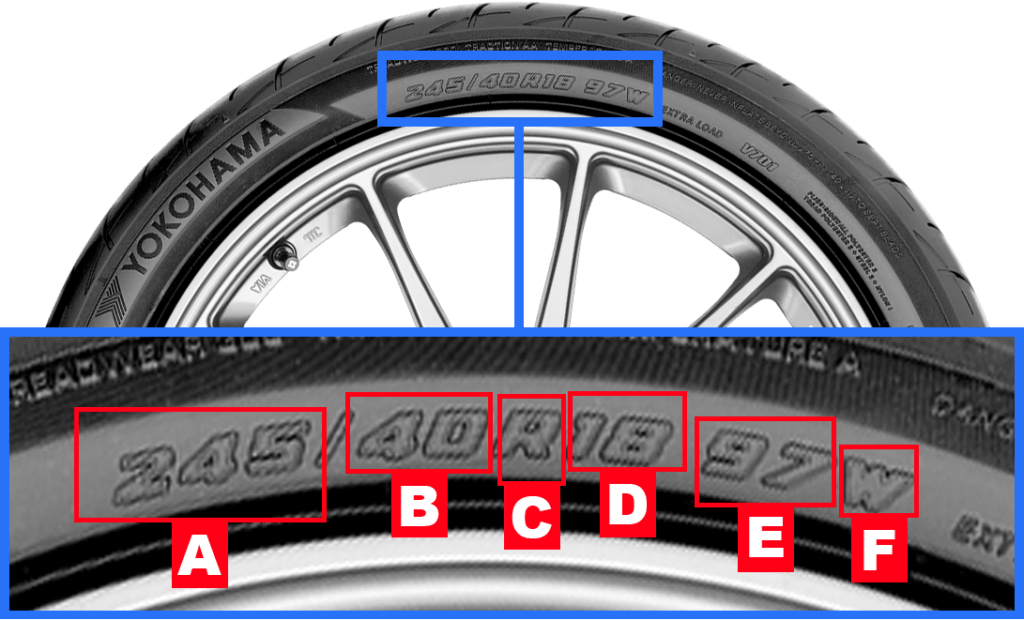
Illustration: Tire size components on Yokohama Advan Fleva V701
- A → Tire Width: 245 millimeters
- B → Aspect Ratio: 40 (40% of the tire width which in this case is equal to 245mm x 0.40 = 98mm)
- C → Construction Type: Radial
- D → Rim Diameter: 18 inches
- E → Load Index: 97 ( max 730kg or 1610 lbs / tire)
- F → Speed Rating: W (up to 270km/h or 168mph )
This visual aid will provide a clear and concise reference to help you decode tire size codes accurately.
Armed with this step-by-step guide and visual aid, you’re now equipped to read and understand tire size codes like a pro. In the next section, we’ll address some frequently asked questions to further enhance your knowledge about tires and their specifications.
Frequently Asked Questions (FAQ)
We understand that tire sizes and numbers can be a source of confusion for many car owners. To address your concerns and provide further clarity, we have compiled a list of frequently asked questions about tire sizes and numbers. Let’s get to the bottom of these queries!
It’s generally recommended to stick to the tire size specified by the vehicle manufacturer. Changing the tire size can affect your vehicle’s performance, including speedometer accuracy, handling, and fuel efficiency. If you’re considering a different tire size, consult a tire professional to ensure compatibility with your vehicle.
Using tires with different aspect ratios can impact the overall diameter and circumference of the tire. This discrepancy may affect the accuracy of your speedometer, the vehicle’s suspension, and the performance of the ABS system. It’s best to maintain consistent aspect ratios across all tires.
The tire’s rim diameter must match the rim size specified by the vehicle manufacturer. It’s essential to refer to your vehicle’s owner’s manual or consult a tire professional to ensure the proper fitment.
The “P” in the tire size code stands for “passenger” and indicates that the tire is designed for use on passenger vehicles. Other letters, such as “LT” for light truck or “ST” for special trailer, signify tires designed for specific vehicle types.
Tires should be replaced when the tread depth reaches 2/32 of an inch or when they show signs of excessive wear, cracking, or bulging. Regularly inspect your tires and consult a tire professional to determine the appropriate time for replacement based on your driving habits and conditions.
No, tires have different load capacities depending on their size, construction, and load index. It’s crucial to choose tires that can support the maximum load requirements of your vehicle to ensure safety and optimal performance.
The speed rating indicates the maximum speed at which a tire can safely operate. It’s important to select tires with a speed rating that meets or exceeds your vehicle’s maximum speed capability. Adhering to speed limits and driving responsibly is always recommended for safety.
It’s generally not recommended to mix different speed-rated tires on a vehicle. Tires with different speed ratings may have different performance characteristics and may affect the vehicle’s handling and stability. It’s best to consult a tire professional for guidance on selecting tires with matching speed ratings.
We hope these answers have shed light on some common questions related to tire sizes and numbers. If you have any further inquiries or need personalized assistance, don’t hesitate to reach out to a tire professional or refer to your vehicle’s manufacturer guidelines.
Remember, your tires are the only point of contact between the road and your car. Proper tire maintenance is equally important. Regularly inspect your tires for signs of wear, maintain proper inflation levels, and ensure they are rotated and aligned as recommended by the manufacturer. These practices can extend the lifespan of your tires and enhance your vehicle’s overall performance.
If you ever find yourself uncertain about tire sizes or facing specific concerns, don’t hesitate to seek professional advice. Tire experts can provide valuable insights tailored to your specific vehicle and driving needs.
Safe travels!
